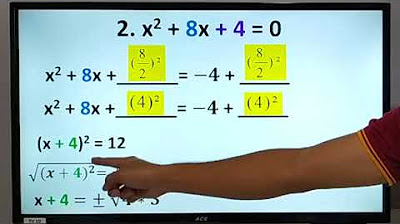INTRODUCTION TO QUADRATIC EQUATIONS | GRADE 9
Summary
TLDRThis educational video script targets grade 9 students delving into quadratic equations. It introduces quadratic equations as those with the highest variable exponent of 2. The script defines the equation's degree, explains the standard form ax^2 + bx + c = 0, and distinguishes between complete and incomplete quadratic equations. It guides students through identifying quadratic terms, linear terms, and constants in equations. The video also includes exercises to test understanding and concludes with a summary of key concepts, promising further exploration in upcoming videos.
Takeaways
- 📘 The first topic in grade 9 math is quadratic equations.
- 🔢 A quadratic equation is defined as an equation with the highest exponent of the variable being 2.
- 📚 The objectives of the video include understanding what a quadratic equation is, recognizing examples, and solving exercises with accuracy.
- 📐 The degree of an equation is determined by the highest exponent of the variable, which for a quadratic equation is 2.
- 🔍 Examples are provided to differentiate between quadratic and non-quadratic equations based on the highest exponent.
- 📝 The standard form of a quadratic equation is ax^2 + bx + c = 0, where a, b, and c are real numbers and 'a' cannot be zero.
- 🔑 The terms in a quadratic equation are identified as the quadratic term (ax^2), the linear term (bx), and the constant term (c).
- 🧩 Incomplete quadratic equations can lack one or more of the terms (bx or c), but 'a' must not be zero.
- 📉 The video provides exercises to test the understanding of identifying quadratic equations.
- ✅ The video concludes with a summary emphasizing the definition, standard form, and components of a quadratic equation.
Q & A
What is the definition of a quadratic equation?
-A quadratic equation is an equation where the highest exponent of the variable is 2.
What is the significance of the term 'quadratic' in quadratic equations?
-The term 'quadratic' comes from the word 'square' because the variable gets squared, like x squared.
What is the standard form of a quadratic equation?
-The standard form of a quadratic equation is written as ax squared plus BX plus C equals 0, where a, B, and C are real numbers and a must not be equal to 0.
What are the three terms in a quadratic equation?
-The three terms in a quadratic equation are the quadratic term (ax squared), the linear term (BX), and the constant term (C).
Why must 'a' not equal zero in a quadratic equation?
-In a quadratic equation, 'a' must not equal zero because if 'a' is zero, the equation is no longer quadratic.
Can you provide an example of a quadratic equation?
-An example of a quadratic equation is 3x squared minus X minus 5 equals 0.
How do you identify if an equation is quadratic by looking at its highest exponent?
-An equation is identified as quadratic if the highest exponent of the variable is 2.
What is an incomplete quadratic equation?
-An incomplete quadratic equation is a quadratic equation that may lack one of the terms (BX or C), such as ax squared plus BX equals 0 or ax squared equals 0.
What happens to the degree of an equation if the highest exponent is not 2?
-If the highest exponent is not 2, the degree of the equation is determined by that highest exponent, making it not a quadratic equation.
How do you find the values of 'a', 'B', and 'C' in a quadratic equation?
-In a quadratic equation, 'a' is the coefficient of the x squared term, 'B' is the coefficient of the x term (or 0 if there is no x term), and 'C' is the constant term.
What is the significance of the equal sign in a quadratic equation?
-The equal sign in a quadratic equation signifies that the expression on the left is equal to the expression on the right, making it an equation.
Outlines

Dieser Bereich ist nur für Premium-Benutzer verfügbar. Bitte führen Sie ein Upgrade durch, um auf diesen Abschnitt zuzugreifen.
Upgrade durchführenMindmap

Dieser Bereich ist nur für Premium-Benutzer verfügbar. Bitte führen Sie ein Upgrade durch, um auf diesen Abschnitt zuzugreifen.
Upgrade durchführenKeywords

Dieser Bereich ist nur für Premium-Benutzer verfügbar. Bitte führen Sie ein Upgrade durch, um auf diesen Abschnitt zuzugreifen.
Upgrade durchführenHighlights

Dieser Bereich ist nur für Premium-Benutzer verfügbar. Bitte führen Sie ein Upgrade durch, um auf diesen Abschnitt zuzugreifen.
Upgrade durchführenTranscripts

Dieser Bereich ist nur für Premium-Benutzer verfügbar. Bitte führen Sie ein Upgrade durch, um auf diesen Abschnitt zuzugreifen.
Upgrade durchführenWeitere ähnliche Videos ansehen

Fungsi Kuadrat Bagian 1 - Matematika Wajib Kelas X m4thlab

Math8 1G LV4 - Completing the Square and Quadratic Formula

How to Solve These Quadratic Equations?

Solving Equations Transformable into Quadratic Equations

SOLVING QUADRATIC EQUATIONS BY EXTRACTING SQUARE ROOTS || GRADE 9 MATHEMATICS Q1

Kurikulum Merdeka Matematika Kelas 8 Bab 3 Persamaan dan Pertidaksamaan Linier Satu Variabel
5.0 / 5 (0 votes)
